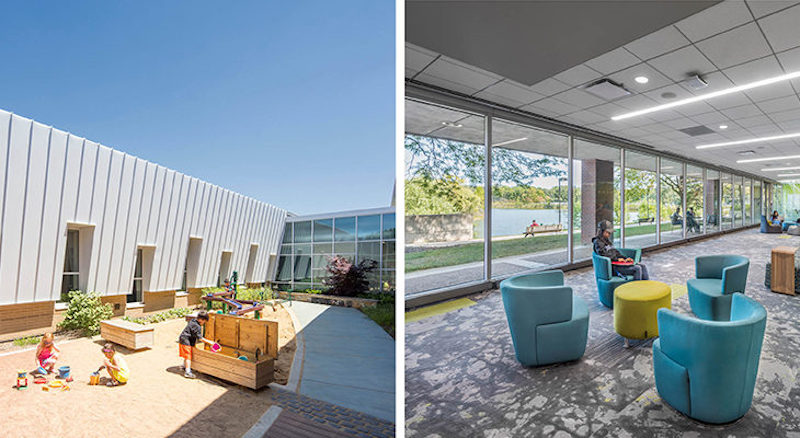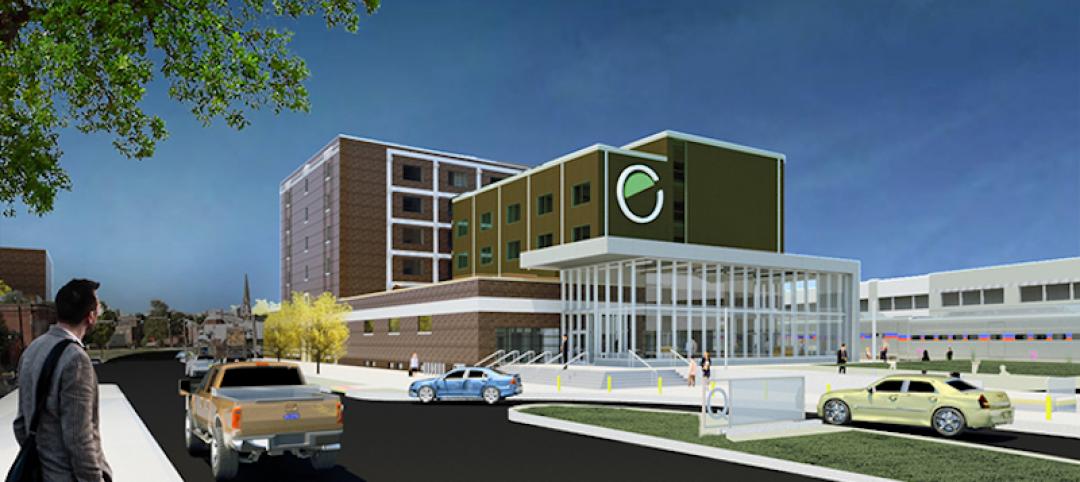In the decades since the 1970s, we’ve learned a great deal about how to take advantage of the sun to not only reduce building energy consumption, but also to shrink operational expenses. Recent years have seen an upswing in the use of solar technologies ranging from photovoltaic panels to solar thermal energy collection. The question that immediately comes up among building owners is, of course, “What’s it going to cost?”
However, before building owners intent on harnessing the sun’s energy start making decisions about specific technologies, they should consider two aspects of architectural design that can maximize the delivery of daylight and views to the outdoors with no real cost impact: building orientation and massing—in other words, the building’s placement on the site and the building’s form in three dimensions. In a moderate/cool climate, the largest contributors to a building’s annual energy use are heating and lighting sources. Our planet happens to be circling a free source of heating and lighting—we just have to expend a little effort to capture it.
Daylight coming directly from the east and west when the sun is low in the sky causes glare, which can lead to eye pain and distract people from their work or studies. Additionally, this direct daylight is less consistent throughout the day and leads to potentially excessive heat loads that force air conditioning systems to work harder. South daylight is far more easily controlled with sun shading devices, while windows facing north provide diffuse, gentle daylight due to access to the skyline without direct sunlight.
Proper orientation is a way to set the project on a path for success when it comes to energy use and human health and performance. For additional resources, check out this tool for calculating solar position by location and this Whole Building Design Guide.
The following diagrams illustrate three types of massing and their impact on daylighting. The illustrations can be applied to any building type. Note the diagrams assume Chicagoland as the facility location; results will vary based on location. Also, up indicates north for each diagram.
The purple portions of the diagrams signify solar positioning. The top border of the purple area indicates the sun’s path through the sky at the summer solstice, while the bottom border shows the path at the winter solstice. The shaded area represents the months between the extremes. The orange lines within that area are sunrise and sunset during the winter solstice. More generally, the graphs are abstractions of the tool that designers use to calculate the sun’s horizontal angle from any point at any time of the day during any day of the year.
You might notice that the diagrams show both angled and rectilinear massing. This shows a “zone of flexibility” built into the diagrams. Walls do not need to face directly south for optimal daylight delivery—they can be up to ten degrees off and still perform well.
 East/west orientation of a linear mass allows for maximum reception of daylight from the south and the north.
East/west orientation of a linear mass allows for maximum reception of daylight from the south and the north.
 College of Lake County’s LEED Platinum-certified Science and Engineering Building exemplifies bar massing. The simple geometry allows natural light to reach deep into the facility.
College of Lake County’s LEED Platinum-certified Science and Engineering Building exemplifies bar massing. The simple geometry allows natural light to reach deep into the facility.
“Bar” Massing
When it comes to maximizing daylight to outdoor spaces, the simplest massing proves the most effective. An east/west orientation of a linear mass maximizes daylight from the south (direct sunlight) and the north (indirect sunlight). This building type works better with smaller, less complex buildings; conversely, I recommend avoiding it for larger buildings that might be more complicated.
 H massing allows approximately half the outdoor space to receive daylight throughout the summer, fall, and spring seasons.
H massing allows approximately half the outdoor space to receive daylight throughout the summer, fall, and spring seasons.
Waukegan’s City Hall, which connects to the police station to its north, demonstrates H massing.
“H” Massing
This type of massing involves two basically parallel volumes connected by a smaller volume. During all seasons except winter, daylight touches about 50% of the outdoor spaces. The strategy works particularly well for larger building types that function well with “wings” or departments. Examples include schools, hospitals, and office buildings. The massing can also be improved if the northmost wing is taller in elevation than the southmost one, and vice versa (though conditions would be worse if the south bar is taller).
 Enclosure on all four sides off an interior courtyard allows additional protection from east/west winds, but also reduces light fall during morning and afternoon hours.
Enclosure on all four sides off an interior courtyard allows additional protection from east/west winds, but also reduces light fall during morning and afternoon hours.
 Built around a courtyard, Jefferson Early Childhood Center exemplifies O massing. The layout maximizes views toward the outdoor space and blocks wind to create a more comfortable play setting.
Built around a courtyard, Jefferson Early Childhood Center exemplifies O massing. The layout maximizes views toward the outdoor space and blocks wind to create a more comfortable play setting.
“O” Massing
In this scenario, the facility encloses a courtyard. A downside is that it limits daylight to the courtyard. Conversely, O massing helps block east and west winds, providing more comfort for those in the courtyard. I suggest using this for building types that require more flexible circulation patterns, since there is not a single pinch point for travel between the parts, like in H massing. Additionally, it works well for building owners who prefer a completely enclosed outdoor space. O massing also creates more opportunities for viewing the outdoors from the interior.
 Oakton Community College’s Margaret Burke Lee Center for Science and Health Careers features an east-west orientation and massing that takes advantage of the sun’s angle in the sky.
Oakton Community College’s Margaret Burke Lee Center for Science and Health Careers features an east-west orientation and massing that takes advantage of the sun’s angle in the sky.
Early Decisions and Their Consequences
Choices about massing and orientation made early in the design process have huge impacts down the line. The wrong choices can lead to many complaints—just ask building occupants who have to deal with views of mechanical equipment, glare from low winter sun, or overheated or underlit rooms.
Next time you start planning a building project, make sure to ask your architect about massing and solar orientation. Ask for early energy models as soon as preliminary massing options are available.
The diagrams above are a start. None of them is always the correct solution. It all depends on the scale of the project, site conditions, and owner preferences about how the building relates to exterior spaces.
Keep in mind that some massing strategies may result in higher upfront costs, but can have a desirable return on investment due to energy savings and reduced operations and maintenance costs. Additionally, building owners should discuss with their architects how occupant access to nature and daylight can create greater engagement, wellness, and happiness among regular occupants or visitors.
If all this points to anything, it’s this: architects need time and space to think about the consequences of early decisions. Thus, I encourage building owners to resist the temptation to rush the early part of the design process to get to the “real” part of the project. Aristotle said it best: “Well begun is half done.”
More from Author
Legat Architects | Feb 9, 2024
Disability and architecture: ADA and universal design at college campuses
To help people with disabilities feel part of the campus community, higher education institutions and architects must strive to create settings that not only adhere to but also exceed ADA guidelines.
Legat Architects | Jun 5, 2023
How to achieve cost-effective kindergarten classrooms
Educational architect Robin Randall shares realistic advice about the challenges of adding developmentally appropriate, play-based kindergarten classrooms while respecting budget limitations.
Legat Architects | Dec 19, 2022
Ohio University’s OHIO Esports Arena redefines video gaming
If a college student enjoys film studies, there is probably a place on campus where they can join other film buffs. But where can students who like video games go?
Legat Architects | Nov 30, 2022
10 ways to achieve therapeutic learning environments
Today’s school should be much more than a place to learn—it should be a nurturing setting that celebrates achievements and responds to the challenges of many different users.
Legat Architects | Jun 20, 2022
An architectural view of school safety and security
With threats ranging from severe weather to active shooters, school leaders, designers, and security consultants face many challenges in creating safe environments that allow children to thrive.
Legat Architects | Jul 28, 2017
Achieve hospitality architecture that impresses – Multigenerational appeal, local connections
Did guests get the experience that they paid for? This question has long haunted hotel operators.
Legat Architects | May 16, 2017
Architecture that helps children fall in love with the environment
The coming decades present a major ecological challenge... so let’s encourage the next generation to do something about it!
Legat Architects | Mar 30, 2017
Train station architectural design fundamentals: Accessibility
If safety is the number one priority for train stations, then accessibility comes in at a close second.















